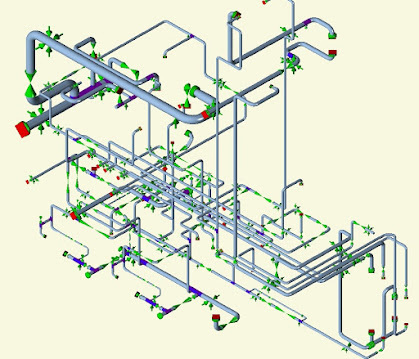Flare System & its Requirements
Gas flaring is a combustion device to burn associated, unwanted or excess gases and liquids released during normal or unplanned over-pressuring operation in many industrial processes, such as oil-gas extraction, refineries, chemical plants, coal industry and landfills.
Flare systems provide for the safe disposal of gaseous wastes. Depending on local environmental constraints, these systems can be used for:
1) Extensive venting during start up or shutdown
2) Venting of excess process plant gas
3) Handling emergency releases from safety valves, blow-down, and depressuring systems
- Design will vary considerably, depending on the type of connected equipment and complexity of overall system. A flare system generally consists of an elevated stack, means to maintain burning conditions at the top of stack.
- Whenever industrial plant equipment items are over pressurized, the pressure relief valves provided as essential safety devices on the equipment automatically release gases and sometimes liquids. Those pressure relief valves are required by industrial design codes and standards, as well as by law.
- The released gases and liquids are routed through large piping systems called flare headers, to a vertical elevated flare. The released gases are burned as they exit the flare stacks. The size and brightness of the resulting flame depend on the flammable material’s flow rate in terms of joules per hour.
Working of flare system:
Based on height of flare tip, flares can be categorized into two types:
Ground flare:
1) Open ground flare
2) Enclosed ground flare
Elevated flare:
1) Self supported flare
2) Derrick supported flare
3) Guyed stack flare
Types of flare based on mixing at flare tip:
2) Air assisted flares
3) Pressure assisted flare
4) Non-assisted flare
Ground Flare:
A Ground Flare is where the combustion takes place at ground level. It varies in complexity and may consist either of conventional flare burners discharging horizontally with no enclosure or of multiple burners in refractory-lined steel enclosures. Ground flares is the preferred choice only if plant is located in an area where it is highly desirable to have a flare which is not visible in public.
Open Ground Flares:
Here Flare Headers distribute and the flaring occurs at ground, with the area surrounded by radiation fences. Most have multiple burners that combine to flare large amounts of gas. The burners are located either in a refractory lined enclosure or in a pit. Open ground flare can combust large quality than enclosed flares. Another type of ground flares is the horizontal flare which is located in an open pit.
Enclosed ground flares:
Enclosed ground flares are the most practical ground flare type for industries located in city areas. While they are expensive, they provide a means of smokeless combustion without a flame visible to the surrounding area. Hot combustion gases from an enclosed ground flare are discharge to the atmosphere through an opening at the top of the refractory lined enclosure.
Elevated Flares:
For safety reasons it’s a advantage to have flares at considerable height from ground. Elevated flares are preferred over enclosed ground flares due to lower costs. Elevated flares are also preferred over open pit ground flares due to lower land requirements.
Self-supported flares:
The self-supporting stack is a freestanding stack anchored to a base Self-supported flare system is used for lower heights when radiation exerted is low. It uses less space for installation. Self-supporting flares are generally used for lower flares tower heights 9mtr to 30mtr but can be designed for up to 75mtr.
Derrick supported flares:
The derrick supported stack is located in the centre of a derrick structure and is held to the structure by tie rods and guides. Derrick supported flares can be built to a considerable height since the system load is spread over the derrick structure. Derrick supported flare system is optimum installation for higher heights where high radiation is exerted. Derrick supported flares are the most expensive design for a given flare height. The derrick supported stacks have been built for around 120mtr Height.
Flare gas transportation Piping:
Waste gases from vents, blowdown gases released from pressure relief devices are sent to the flare stack through the gas collection header. This piping should be designed to have minimum pressure drop. Potential dead legs and liquid traps are avoided. Use of valves in this line should be kept to minimum and when used should be sealed to open position. The piping should be equipped for purging so that explosive mixtures do not occur in the flare system either on start up or during operation. Minimum slope of the flare header shall be 1:450 (as per API 521).
Vessels & Drums used in Flare system:
Mainly four type of vessels or drums used in design of flare system:
1) Knockout drum
2) Blowdown drum
3) Quench drum
4) Seal drum
Knockout Drum:
Liquid present in the vent stream or liquid that may be condense out in collection header and transfer lines are removed by the Knockout drum. The knockout drum may be horizontal or vertical type.
A knockout drum is required where enough hydrocarbon liquids are entrained with or condensed from gas to avoid possible fire hazards from liquid droplets falling out of the flare. The function may be combined with that of blowdown drum to provide a single drum, where small quantities of liquid are involved.
The knockout drum may be either horizontal or vertical. Horizontal drums are more common for large relief loads for the following reasons:
-The required elevation of the relief header is lower than for a vertical drum.
-The horizontal drum would cost less than the vertical drum which has equivalent capacity.
Blowdown drum is used when sizable liquid releases from process is required to be captured. The releases may be intentional like drainage from liquid drain system during shutdown or start up- or emergency vents of PSV discharge. The drum may be capable of accepting the anticipated liquid loads without filling beyond maximum operating level of drum. This maximum operating level must provide a gas flow path with sufficiently low gas velocity to allow gravity separation and prevent re-entrainment beyond design droplet size. Blowdown drums is located near sources, close to battery limits of a process unit or area to reduce to reduce amount of piping subject to two phase slug flow.
A quench drum can be used to condense vapour discharge from relief device for either later return into the process after relieving condition has passed or for disposal to sewer. Generally a Quench drum is provided whenever the material being relieved is too valuable to be burned in a flare or too toxic to be relieved to atmosphere. A Quench drum can be used to cool hot material so that the entire relief system does not need to be designed for higher temperature. Other purpose for quench drum is to quench runaway reactions.

































.jpg)







































Follow Us
“Science is about knowing, engineering is about doing.”